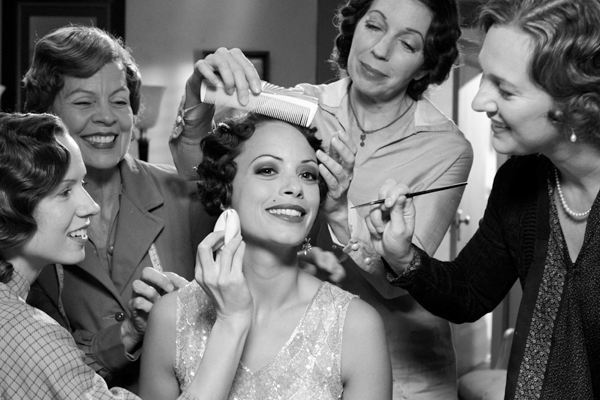Brighton ‘city of film’

Frank Gray projected a moving image of Brighton as the next ‘city of film’. Frank le Duc reports
Picture the scene. A low-lit interior. A gently spoken film buff pitches his script. Frank Gray tells his hard-bitten audience: “Brighton and Hove has an unrivalled place in the history of film, an enviable presence in the present and a big part to play in its future.” They may not have been his exact words but that was the gist of his plot. Dr Gray is telling a story about our creative and digital city harnessing its rich heritage and building on its current credentials to boost jobs, tourism and businesses here.
His plot involves setting up a film office, attracting more filmmakers and burnishing our image to attract more visitors. One way to achieve this would be to become an official “film city”. He has been telling politicians, officials and others how this could be achieved. His goals are about much more than the films that we watch at the cinema. They include everything from educating people about our place in the history of moving pictures to the sharing of slices of life captured on Super 8, video and smart phone.
He accepts that the big screen will be the main attraction for many. And Brighton isn’t short of stardust. Names associated with the city range from Richard Attenborough and Laurence Olivier to Cate Blanchett and Dakota Blue Richards. And more than 60 feature films have been made here in whole or in part in the past 80 years.
Asked to name his own favourites, he reeled off Brighton Rock, The End Of The Affair and Carry On At Your Convenience. But he also played a little-seen black and white clip to an audience of politicians and officials at Hove Town Hall. It showed Magnus Volk’s shortlived “Daddy Longlegs” railway serenely gliding above the sea. His audience watched with an appreciative awe.
Even this rare clip came with a story of its own. Dr Gray said: “Most of the films made between 1895 and 1910 have been lost. Only two per cent survive. I’m often asked what missing film would I most like to see? I always gave the same answer – a film of Volk’s sea-going electric car from 1895. It turned up in Barcelona three years ago.”
“Most of the films made between 1895 and 1910 have been lost. Only two per cent survive”
Dr Gray has been associated with Brighton University for more than 25 years, first as a lecturer in art and film history and now as the director of Screen Archive South East. He is also a co-director of the CineCity film festival. He said: “Brighton and Hove should become a ‘film city’. The city has a powerful cluster of film-related organisations, practices and activities that gives it a very distinctive creative character. But to date they have not been brought together into an effective and dynamic whole.”
He said that a cohesive film cluster would generate benefits to the creative and cultural economy of Brighton and Hove, adding: “Film is much more than exhibition. It’s not about just going to the cinema. Filmmaking manifests in many different ways, especially because of the digital revolution. Filmmaking is no longer the soul preserve of the industry.”
He cited:
• The film and television industries, making features, series and documentaries
• Advertisements
• Corporate
• Pop video
• Amateur
• Artists
• Students
• Children
He said: “Filmmaking is only one aspect of the city’s film culture. What are the elements that would make up our film cluster?” He added that the unique strength of Brighton and Hove’s proposed film cluster would be its cross-sector combination of features such as:
• Its history and heritage
• Archive and museum collections
• Festivals
• Exhibition
• Education
• Production
• Cine-tourism
• Special events
He said that a film cluster would help to “create a new and dynamic identity for the city, a new brand, a new story and would nurture a different sense of the city – both historically and right now”. He said that it would also “make best use of existing resources and attract new inward investment”. He called on the council to help make the business case for a film office, especially for new productions. But he said that it should also look at the education and training needed to equip local people for work in the industry.
A city of film
A next step, he suggested, would be for the film cluster to apply to UNESCO to become a “City of Film”. Bradford and Sydney have already gained film city status. He said that UNESCO had listed a set of requirements which were well met by Brighton and Hove. They included:
• Notable infrastructure related to filmmaking, ie, film studios, cultural/movie landscapes, cinematographic memorabilia, etc
• Historic links to the production, distribution and commercialisation of films, especially within a native/local and culturally relevant context
• A cinematographic legacy in the form of archives, museums, private collections and/or film schools
• A tradition of hosting film festivals, screenings and cinematographic events
• The birthplace, residence and/or workplace of creators and artists in the film industry
• Depiction of the city in films, preferably realised by native creators and artists, and existing films about the city.
Dr Gray addressed all these points in his pitch to the politicians, pointing out that the city has an impressive film heritage. He said: “Brighton and Hove were at the forefront of the birth of cinema. The practices and studios established by George Albert Smith and James Williamson established the fundamental principles of film editing. Referred to as the ‘Brighton School’, these pioneer filmmakers are famous throughout the world.”
England’s Hollywood
Brighton and Hove was the equivalent of Hollywood – before Hollywood existed – and film editing and the idea of the close-up shot were invented here. Dr Gray said: “Over 60 feature films have been made in the city making it, after London, the most filmed city in the nation. Feature films include Brighton Rock, Quadrophenia and Carry On At Your Convenience. This history has established the city’s significant place in the history of British cinema.”
He pointed out that Brighton has the country’s oldest functioning cinema, the Duke Of York’s Picturehouse, and the city’s screen heritage organisations included Brighton Museum, Hove Museum and Screen Archive South East. The latter is the regional film archive and was set up 20 years ago. It is based at Brighton University.
In addition, Brighton has its own film festival, CineCity, which will be in its 10th year in November. CineCity presents British premieres alongside an international programme, artist films and features, works by local film-makers and has a rich archive and heritage strand. Last year the festival presented The Artist at the Duke Of York’s three months before its UK release and five months before its success at the Oscars. CineCity also programmes the film events at the Brighton Festival.
Brighton hosts the world’s first film festival for filmmakers with learning disabilities – Oska Bright – which now tours internationally. And there is an annual documentary film festival – SEE – as well as other festivals incorporating film and moving image.
In terms of education, he highlighted
• Courses at Sussex University, Brighton University and City College
• Private film school recently under new ownership
• Sixth form college film consortium
• A specialist school at Patcham High, which hosts an annual film awards ceremony for children at the Duke Of York’s
• An emerging creative entrepreneur programme in partnership with Lighthouse and CineCity at the Brighton Aldridge Community Academy
• Work at the Portslade Aldridge Community Academy
Dr Gray said: “The city is also attractive to filmmakers with a mixture of potential locations encompassing sea, urban areas, countryside, village and a range of architecture. The city has been a backdrop for feature films (Wimbledon, The Boat That Rocked), film shorts, TV series (EastEnders, The Inspector Lynley Mysteries) and adverts (Lucozade, eHarmony).
“It is also a significant base for emerging filmmakers. Lighthouse runs the Guiding Lights scheme for the BFI – the UK’s most prestigious film industry mentoring scheme – and also has been selected to run the BFI’s new Short Film Fund.
“Visit Brighton promotes the city’s film heritage through its web pages and its movie map of film locations. During the Centenary of Cinema in 1996, four centenary plaques were erected in the city marking the site of the first screening (25 March 1896 – the first city in the UK after London), the pioneers’ studios and the Duke Of York’s. Walking tours now visit all of the city’s famous film locations.
“The city has a long tradition and successful track record in producing outdoor events, including a dedicated team at the city council that co-ordinates permissions and logistics for council owned land. This means there is a dynamic attitude among licensing and statutory authorities and generally, support or tolerance of the disruption, from residents and businesses.
“In 2011 the outdoor events team handled 135 film-related projects generating £34,000 income. This was just outdoor filming on council-owned land and does not include the Royal Pavilion, private outdoor locations or studio and indoor-based productions.
“The city has a strong skill base across all aspects of film production and pre-production: producers, filmmakers, writers, performers, set builders, designers, animators, technicians, production crew, PR and marketing companies, stewards and security, caterers, etc.”
Like a film director without the noisy ego, Frank Gray is calling the actors on to the set. In this case the actors include the councillors and officials who, unusually, applauded him after his presentation. It’s fair to say that he inspires his audience with his black and white glance at the past, his survey of the current scene and the glimpse he offered into a promising future.
The narrative is clear as Dr Gray tries to bring together various organisations with different goals in the hope that they will work cohesively. His plan for a film office to stimulate new production in the city, promote cine-tourism and support the related careers opportunities won’t happen without funds. And this isn’t a big budget picture. As he stepped back from microphone at Hove Town Hall, the script may have read: “Fade.” It is of course too early for the credits to roll. Cue the cameras and hope the right people focus on what could well be Brighton’s next big idea.
Image: The Help




















